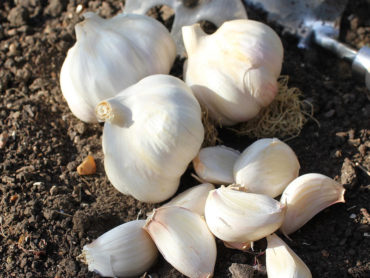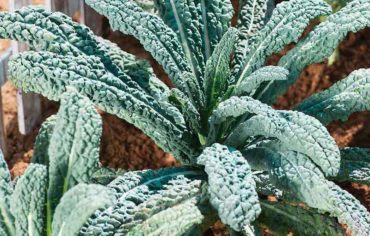Growing vertical vegetables gives you a bumper yield from a small space at the same time as allowing better air circulation around your plants. It also deters pests, reduces the chance of rot and makes harvesting much easier. What’s more, you can create a real sense of drama in your garden with a few carefully placed A-frames, sections of trellis or veg-laden arches. Here are some tried-and-tested tips from the expert growers who really know how to make every inch of space count…
In the meantime, browse our full range of vegetable plants for more inspiration.
- Best advice on which veg to grow vertically
- Best advice on how to support vertical veg
- Best tips for growing vertical vegetables
Best advice on which veg to grow vertically
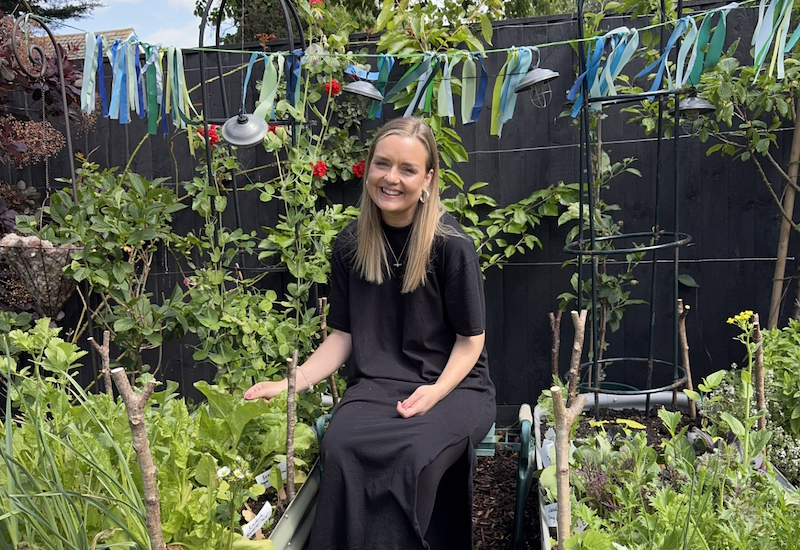
Incorporate vertical growing on your garden boundaries
Image: Mel Darvill
Aside from traditional climbing veg such as tomatoes, cucumbers and runner beans, Nick Moyle from Two Thirsty Gardeners says that squash is a great choice for vertical growing. “Red Kuri, Crown Prince and the unusual Spaghetti Squash are among our favourites,” he says.
YouTuber Terry from Terry King’s Allotment Gardening On A Budget likes to train Climbing Bean ‘Cobra’ up vertical supports, but for something unusual, he also recommends luffas. He says that the fruits hang well, and really benefit from the extra height. Terry’s vertical growing doesn’t stop at canes, chicken wire and trellis. Try his other tip, and simply suspend buckets of strawberries, lettuce and salad crops wherever you can!
Karen from @welliesandwaffles says you don’t need to concentrate on climbing vegetables for vertical growing. Rather than the usual flowers, she fills hanging baskets with tumbling tomatoes and basil – attractive and edible! Hanging baskets are also a great way to grow things like strawberries and herbs.
Andrew & Paul from YouTube channel Mad About Gardening like to grow strawberries in stackable towers to get the maximum yield from a very small space. But they’re not just for strawberries. They say that a whole vegetable or herb garden can be grown this way.
Steve Newland from @snewland97 agrees that there’s loads of things that can be grown vertically, from traditional runner beans and peas to cucumbers, tomatoes, pumpkins and courgettes. But have you thought about growing vertical potatoes? He suggests growing your spuds in a stack of hay bales to get a good crop from a small footprint.
Sarah Wilson from @rootsandallpod likes to grow hops (Humulus lupus) up vertical supports. She says that the new shoots can be eaten like asparagus early in the year, while the flowers can be harvested and dried for tea. Later on, the leaves turn a lovely yellow autumn colour and swags of the dried plant can be used for decoration.
Did you know that you can grow courgettes vertically? Silvia from Vegetable Growing says it helps to use a variety with climbing tendencies, such as ‘Black Forest’ F1. She likes to use an attractive wooden trellis, which makes it easy to tie in the plant as it grows. Just remember that courgette stalks really thicken up, so keep the ties fairly loose.
Punam Farmah from Horticultural ‘obbit says that growing butternut squash upwards is fascinating. Most squashes grow out gracefully across the ground but, if you create a tripod structure, Punam says you can create an elegant butternut frame that keeps the fruit away from mini beasts, helps with aeration and allows easy access for pollinating bees.
Over at @diaryofayorkshiregardener, Francesca Chadwick grows tomatoes, cucumbers, melons, beans and peas vertically. She also finds that courgettes and smaller pumpkin varieties work well too. But for an unusual tip, try cape gooseberries (physalis).
Best advice on how to support vertical veg
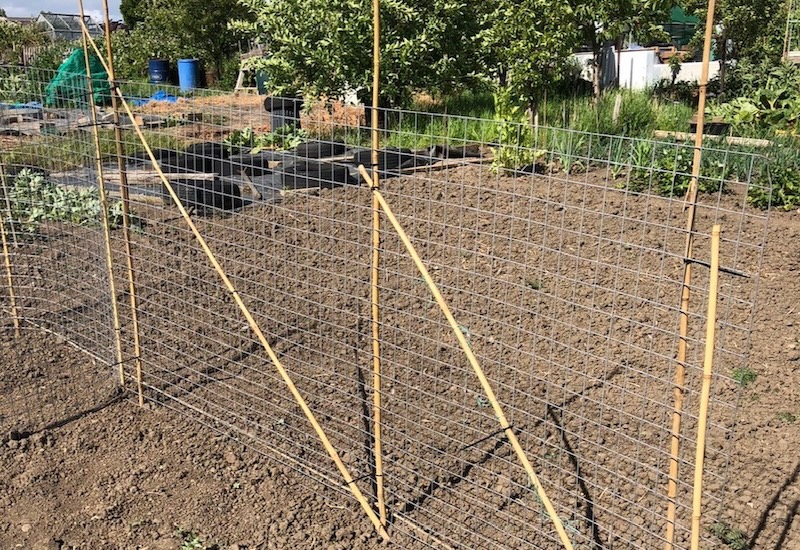
A combination of canes and wire framing gives good support
Image: Steve Newland
The most important thing with vertical veg growing is providing strong enough supports, says Mel Darvill from @melslittlegarden. And be sure to regularly tie anything that needs tying in – that way your plants can put their energy into producing healthy fruits rather than struggling to climb.
Steve Newland from @snewland97 agrees that your frame should be strong enough to support the weight of the plants and their fruits. But, he says, don’t forget that it will also need to be strong enough to withstand strong winds. He recommends using plenty of stakes and canes – pushing them firmly and deeply into the ground.
Becky Searle, author of Grow a New Garden says that vegetables grown vertically can be more prone to wind damage, so her preference is for strong metal arches. As an added bonus, these frames can be used to shelter other crops from strong winds.
Stephanie Muir from @my_veg_adventures has a small veg patch, so she’s an experienced vertical grower. Her favourite supports include bamboo canes woven through chicken wire, hanging baskets on fences, not forgetting the hanging space inside her greenhouse.
For a neat and easy pea frame, Helen Hutchings of @helenlikesplants hammers two support sticks into the ground at either end of her row of planted peas. Then she simply winds long lengths of string around the outside of the posts and coaxes the plants to grow up the middle. If you add new lines of string as your plants get taller, you’ll keep them neatly contained and make the pods easier to harvest.
If you like to grow tomatoes and cucumbers in a polytunnel or greenhouse, you could try Sam’s method, as demonstrated over at @sams_growingfood. Securely tie some strong twine from a cross beam, and bury the loose end in the soil underneath your cucumber plant. Coax your plant to wind its way up the twine as it grows, keeping the fruits safely off the ground and clear of slugs.
Katie Lewis from @themarmaladeteapot says that old tights are the perfect way to support heavy fruits as they grow. This prevents the stems of your plant from snapping under the weight of the crop. She also recommends pruning away any excess foliage to remove more unwanted weight.
Don’t forget to make use of the vertical space over your walkways, says Andrew Oldham from Life On Pig Row. This year he’s growing squashes on arches over a path. Spurred on by a successful apple arch, he says that this method creates a special, gazebo-like feel and the micro-climate beneath benefits other veg plants and flowers.
Another fan of the arch for vertical growing, Kate Royal from Diary of a Country Girl makes her own hazel archways to support runner beans and sweet peas. To really maximise space, she designs her hazel structures so that they straddle two raised beds.
Richard from The Veg Grower Podcast is another fan of hazel supports, using sticks from his own tree that are cut specifically for the purpose. Strong, sturdy and natural, he says that apart from the cost of the tree, they’re free and home grown at his allotment!
Sarah Wilson from @rootsandallpod likes to use foraged twigs and sticks as plant supports in her garden. You can also weave them together to create a self-supporting framework that contains nooks and crannies around which plants can twine. Sarah says that natural plant supports are a good way to re-use waste material from your garden, and best of all, they’re free!
Don’t forget that vertical veg can be ornamental as well as productive! When Ian Bayliss from DIY Home and Gardening built a wooden pergola, he ran ropes vertically from bottom to top, as well as across the roof span to create an attractive display of crops. See how Ian trains his greenhouse cucumbers to make the most of a small space too.
Best tips for growing vertical vegetables
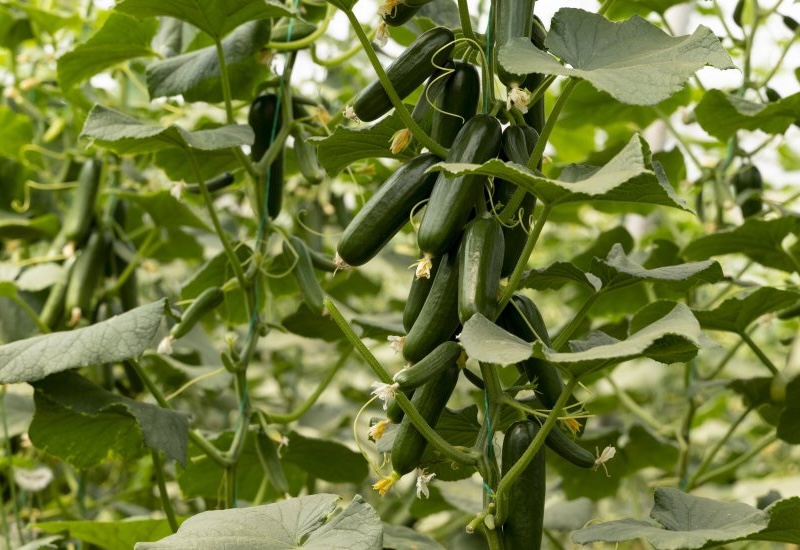
‘Ayda’ is a seedless cucumber with no bitter aftertaste
Image: Cucumber ‘Ayda’ plants from Suttons
Like with any veggies, make sure you’re using a good quality compost, says Mel Darvill from @melslittlegarden. Shop-bought peat free is fine, but homemade is even better! Many climbing veg plants are hungry and thirsty, so water regularly too.
Richard from The Veg Grower Podcast says the main thing to keep an eye on is watering. His container-grown vertical plants definitely need it more often than his ground-planted veggies. As the plants are putting in a lot of effort growing upwards, he always gives them a regular boost with a good liquid feed and, for happy roots, he recommends planting in the biggest pots you can.
Think about how you arrange your vertical veg planting so your taller crop doesn’t prevent others from growing well, says Steve Newland from @snewland97. Crops like fast-growing beans should be at the back with smaller things at the front so they also get enough sun.
Don’t underestimate the eventual weight of the mature plants when building your plant supports, says Sarah Wilson from @rootsandallpod. This is particularly relevant if you’re growing your vertical veg in a greenhouse or polytunnel, as they’re likely to put on a lot of green growth before bearing a crop.
Most plants won’t naturally find their way upwards, and will need some help, says Becky Searle, author of Grow a New Garden. Twist them into the poles, or tie them in place whilst they’re growing. If they have tendrils they will be able to hold on themselves but, if not, you’ll need to keep tying them in.
When tying vertical plants to supporting structures, make sure not to tie them too tightly, says Katie Lewis from @themarmaladeteapot. Also, prune away excess foliage to take some of the weight out of the plant.
If space is tight, growing vegetables in pots is a great option, says Silvia from Vegetable Growing. But her favourite tip to maximise space is to grow lots of different veggies in the same bed. Carrots, beetroots, salads, onions, garlic, and leeks all make great companions and, as they don’t take up much space, they can be planted with vertical veggies like tomatoes, cucumbers, beans, etc. And as an additional bonus, some of them repel pests. Onions, garlic, and leeks are great for keeping aphids away from your veggies. Sylvia always grows garlic with her tomatoes, because it helps to keep pests under control.
The final word goes to Joel Ashton from Wild Your Garden who reminds us that adding vertical veg is a good opportunity to make every square foot of your growing space do double duty – for you and for wildlife. Even a tiny veg patch will buzz with life if you grow a mixture of herbs, flowers and fruit, keeping nature in mind. And if a few peas go to the birds – well, that’s nature’s tax!
We hope this has given you lots of ideas for vertical veg growing. See our guide to small space gardening on patios, balconies and windowsills for even more ideas.
Lead image courtesy of Sarah Wilson
Last Updated on September 29, 2025 by Suttons Horticultural Team



